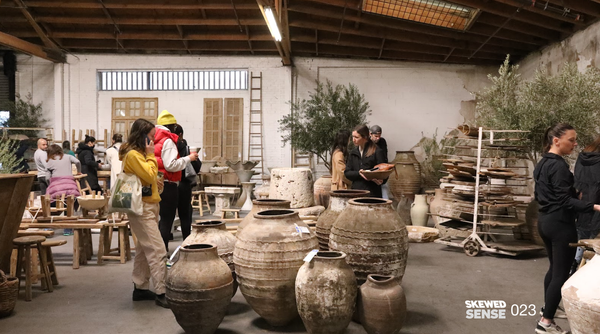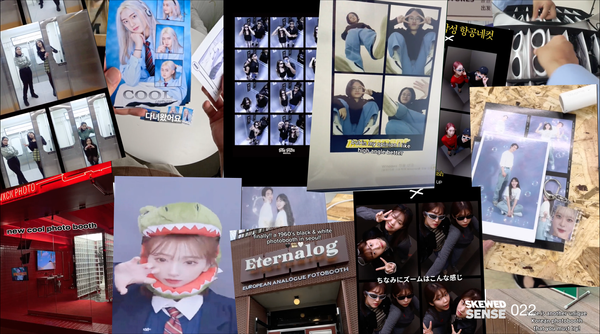014: An Interview With Billy.forsale

BILLY.forsale is the London based exploration of the IKEA archive. The selection on BILLY.forsale has always impeccable, surfacing interesting post-modern design from a company that's sometimes thought of as a behemoth rolling out bland flatpack. Pieces that are covetable to this day.
Full disclosure. BILLY.forsale hosted an exhibition at our Clerkenwell space last year. It ended up being covered by Hypebeast, The Evening Standard and Wallpaper.

SKEWED: How did you start collecting IKEA? You once told me an anecdote about going to Malmo to collect some vintage IKEA catalogues.
Harry: When I was a student about 10 years ago I saw images online of 1980s IKEA catalogues, the furniture on the covers was typical of the decorative postmodern designs of the time and sparked my curiosity into researching older IKEA furniture. I started to very gradually buy pieces that I recognised as IKEA designs shortly after graduating in 2014, including a collection of every IKEA catalogue dating back to 1970 for sale at an auction in Sweden. After winning the auction I realised that the cost of flying to Malmo to collect the catalogues was about 10 times cheaper than paying for shipping so I went to collect them in person and combined it with a trip to the recently opened IKEA Museum in Almhult. It ended up being a bit of an IKEA pilgrimage and was the kick start for me to start seriously growing my collection.
"I've always been drawn to IKEA as a subject, it holds a lot of symbolic weight to me, it's such a universal brand that almost everyone has some form of relationship with."
S: Were you always drawn to vintage IKEA?
H: I’ve always been drawn to IKEA as a subject, it holds a lot of symbolic weight to me, it’s such a universal brand that almost everyone has some form of relationship with. I have a lot of memories as a child visiting IKEA, taking the catalogues home with me and there always being IKEA adverts on tv. The furniture very quickly became so recognisable and iconic to me.
I’m interested in applying the same level of research and historical importance to IKEA furniture as has already been done to designers like Le Courbusier, Aalto, Sottsass etc. The designs have been bought and lived with by so many more people than the aforementioned but it has always had a bit of a dirty reputation for being cheap, poorly made throw away furniture. When you actually look at the collections from over the years there’s so many innovative, radical and influential examples of modern design.
S: The way you merchandise IKEA products tells a certain story about the brand. One that perhaps the brand itself has forgotten a little. It seems to me many of the pieces come from a period when IKEA was able to be fun but also a little postmodern [with Gen Z appeal nowadays]. Some of the designs are even ‘ugly’ but in a cool way. Anyway this was a long way of getting round to - Do you believe there is a golden age of IKEA?
H: The mid 90s catalogues are probably my favourite. You start to notice a lot of influences like Philippe Starck, Ron Arad etc. appearing who’s designs I’m really drawn to as they were kind of superstars of the design world when I grew up. I think it’s really interesting looking at how their hyper futuristic designs filtered down to something so wide scale like IKEA. It seemed a bit more trend driven at the time, people were maybe less concerned with buying longer lasting lifetime pieces than we are now so the designs were often quite bold and out there.
Things started to get a lot more minimal in the early 2000s, you see a sudden shift of all tubular chrome designs of the 80s/ 90s being reproduced in a cheaper metallic grey finish and solid pine being replaced with veneered chipboard. This can seem like a bit of a shame as it could mean maybe the furniture wasn’t as well made/ long lasting at this point but it still says something interesting to me about the changes in consumer priorities/ manufacturing processes etc. at the time.
S: Who are your favourite IKEA designers? We see a strong presence of Niels Gammelgaard and Anna Efvurlund!

H: Niels Gammelgaard is probably the best known of IKEA’s designers, he definitely produced some of my favourite pieces and they were all so well made that a lot of his designs are still readily available on the resale market today. I really like Anna Efverlund’s designs from the 90s / 2000s, lots of smaller, more decorative accessories. Tord Björklund is also a favourite of mine, his designs from the late 1980s/ early 1990s look like they could almost be Mies Van der Rohe designs, he’s also got an element of mystery surrounding him for me too as he’s pretty hard to Google, there’s hardly any information about him online despite him being such an influential designer in terms of IKEA history.
S: Do you look at current IKEA collections at all? Have you spotted any future classics?
"IKEA is so symbolically rich, I'm really not bored of it yet and there's still so much work I want to make around it as a subject."
H: I’m interested in seeing what designers IKEA collaborate with as they’ve always been really good at picking key players from all areas of the design world. A lot of their collaborations are with fashion designers making furniture and homewares for the first time, like Virgil Abloh and Walter Van Beirendonck.
I thought it was really interesting they did a recent collaboration with Zandra Rhodes, the whole collection was pretty crazy and I bought a few pieces from that as I’m interested to see how they mature in a few years time.
S: You mentioned adding new outputs to BILLY which are things you actually make. Are you able to reveal more on this yet?
H: It’s all still very much in progress but I never started BILLY to function solely as a shop, but selling the pieces helps me to buy more to add to the online archive. I think I’m at a good place with the archive now, I’ve found a lot of my hero pieces I’ve really been hunting down for years so now I’m trying to focus on producing my own small editioned designs that fit in alongside the overall IKEA story. I’m wanting to use it as an opportunity to collaborate with friends and other people who’s work I’m interested in, the outcomes could be furniture, objects, artworks, video pieces etc. IKEA is so symbolically rich, i’m really not bored of it yet and there’s still so much work I want to make around it as a subject.
S: Who tends to buy from BILLY? Do you have any customer anecdotes you would be happy to share?
H: I’ve had quite a few instances of people re-buying pieces from me that they originally bought new from IKEA decades ago. I speak to a lot of people who recognise items from my archive that they now say they really regret throwing out. I think by documenting the pieces in such a way and presenting them within the context of an archive has helped give more weight to the objects and bring a new level of appreciation to the older designs.
S: Are you drawn to particular room-sets from old IKEA catalogues?
H: I love them all, there’s always a lot of storytelling with the styling and objects placed around the furniture. I’m really interested in how people appear in the catalogues too. The 70s catalogues are almost treated like it’s Penthouse magazine, with glamorous models in little dresses draped across a sofa smoking a cigarette, then they start showing more specific social groups, one of my favourite from the early 2000s shows a group of students in grungey clothing packed around a tiny kitchen table.
S: What are you looking forward to most in this new year?
H: More collaborations, in person projects and hopefully producing my first editioned BILLY designs.
Conclusions
Unlimited Nostalgia
Why do young people look at vintage IKEA?
Well there's a compendium of reasons that young people are looking at vintage IKEA.
- Democratic design but done smartly. It's kinda similar to why Enzo Mari resonates right now. The value that goes into objects is about care and consideration, not just ostentatious uses of expensive materials.
- Post modern design shows a willingness to look beyond the modernist cannon, which most people now recognise as a failed project which reflects whiteness and patriarchal attitudes
- Escapism from the tyranny of timeless and sustainable. Whilst being actually sustainable as it's all vintage. It's fun to play with vintage IKEA design.
- Nostalgia is HUGE. Everyone is nostalgic now, and unapologetic about it. Nostalgia grabs you by the feels, providing escapism from the inescapable now. Besides how cool is it being able to remix, collage and mash up the entirety of history?
- No-one else is going to have it. Vintage IKEA is in scarcer supply than modern IKEA. Young people prize individuality still.




